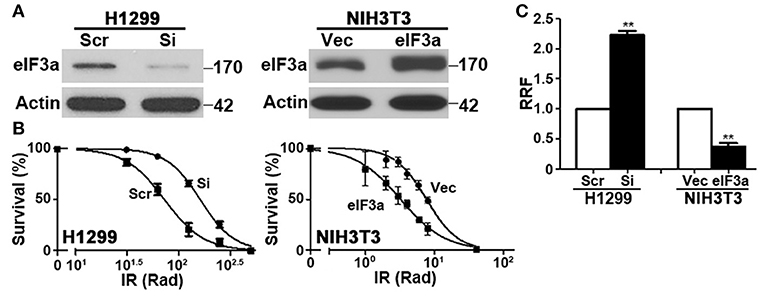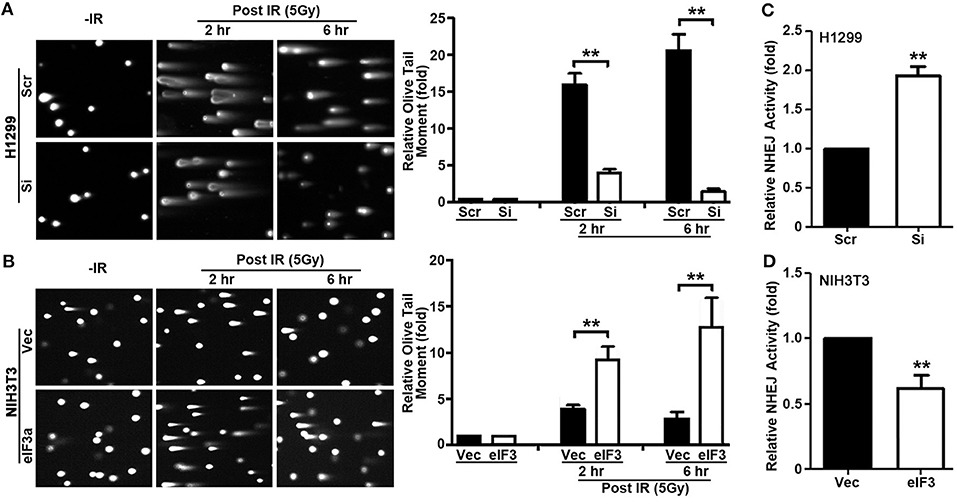
95% of researchers rate our articles as excellent or good
Learn more about the work of our research integrity team to safeguard the quality of each article we publish.
Find out more
CORRECTION article
Front. Cell Dev. Biol. , 07 January 2021
Sec. Cell Death and Survival
Volume 8 - 2020 | https://doi.org/10.3389/fcell.2020.629218
This article is part of the Research Topic Dynamical Networks of Life/Death Decisions in a Cell: From DNA Repair to Cell Death View all 19 articles
This article is a correction to:
eIF3a Regulation of NHEJ Repair Protein Synthesis and Cellular Response to Ionizing Radiation
 Rima Tumia1†
Rima Tumia1† Chao J. Wang1†
Chao J. Wang1† Tianhan Dong1
Tianhan Dong1 Shijie Ma2
Shijie Ma2 Jenny Beebe1
Jenny Beebe1 Juan Chen1
Juan Chen1 Zizheng Dong2
Zizheng Dong2 Jing-Yuan Liu3
Jing-Yuan Liu3 Jian-Ting Zhang1,2*
Jian-Ting Zhang1,2*A Corrigendum on
eIF3a Regulation of NHEJ Repair Protein Synthesis and Cellular Response to Ionizing Radiation
by Tumia, R., Wang, C. J., Dong, T., Ma, S., Beebe, J., Chen, J., et al. (2020). Front. Cell Dev. Biol. 8:753. doi: 10.3389/fcell.2020.00753
In the original article, there was a mistake in Figure 1A and Figure 3A as published. Wrong images for the Western blot of H1299 cells in Figure 1A and for the comet assay of the control un-irradiated H1299 cells in Figure 3A were accidently used for publication. The corrected Figures 1 and 3 appear below.

Figure 1. Effect of eukaryotic initiation factor (eIF)3a expression on the cellular response to ionizing radiation (IR). Western blot analyses (A) and colony formation assay following IR treatment (B) of H1299 cells with transient eIF3a knockdown and NIH3T3 cells with stable eIF3a overexpression compared with their respective control cells. Actin was used as a loading control. Panel (C) shows a summary of eIF3a effects on cellular sensitivity to IR treatments. Relative resistance factor (RRF) was derived by dividing the IC50 of the test cells by that of their control cells (n = 3, **P < 0.01).

Figure 3. Role of eukaryotic initiation factor (eIF)3a in non-homologous end joining (NHEJ) repair of ionizing radiation (IR)-induced double-strand breaks (DSBs). (A,B) Comet assay was used to determine eIF3a effects on the level of DSBs induced by IR in H1299 cells with transient eIF3a knockdown (A) and NIH3T3 cells with stable eIF3a overexpression (B) compared with their respective control cells. The histograms show the summary of quantitative analysis of Olive tail moment in these cells. (C,D) Host cell reactivation assays using reporter constructs were performed using H1299 cells with eIF3a knockdown (C) and NIH3T3 cells with eIF3a stable overexpression (D) compared with their respective control cells (n = 3; **P < 0.01).
The authors apologize for this error and state that this does not change the scientific conclusions of the article in any way. The original article has been updated.
Keywords: eukaryotic initiation factor 3a (eIF3a), DNA repair, radiation, resistance, mRNA translation, protein synthesis, gamma-H2A histone family member X (γ-H2AX)
Citation: Tumia R, Wang CJ, Dong T, Ma S, Beebe J, Chen J, Dong Z, Liu J-Y and Zhang J-T (2021) Corrigendum: eIF3a Regulation of NHEJ Repair Protein Synthesis and Cellular Response to Ionizing Radiation. Front. Cell Dev. Biol. 8:629218. doi: 10.3389/fcell.2020.629218
Received: 13 November 2020; Accepted: 15 December 2020;
Published: 07 January 2021.
Edited and reviewed by: Inna N. Lavrik, University Hospital Magdeburg, Germany
Copyright © 2021 Tumia, Wang, Dong, Ma, Beebe, Chen, Dong, Liu and Zhang. This is an open-access article distributed under the terms of the Creative Commons Attribution License (CC BY). The use, distribution or reproduction in other forums is permitted, provided the original author(s) and the copyright owner(s) are credited and that the original publication in this journal is cited, in accordance with accepted academic practice. No use, distribution or reproduction is permitted which does not comply with these terms.
*Correspondence: Jian-Ting Zhang, amlhbnRpbmcuemhhbmdAdXRvbGVkby5lZHU=
†These authors have contributed equally to this work
Disclaimer: All claims expressed in this article are solely those of the authors and do not necessarily represent those of their affiliated organizations, or those of the publisher, the editors and the reviewers. Any product that may be evaluated in this article or claim that may be made by its manufacturer is not guaranteed or endorsed by the publisher.
Research integrity at Frontiers

Learn more about the work of our research integrity team to safeguard the quality of each article we publish.